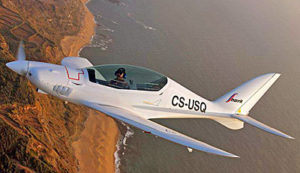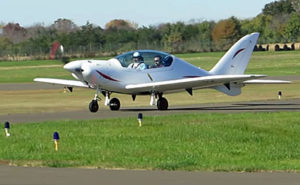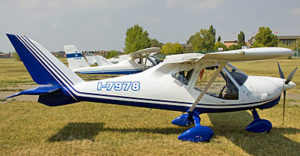Another once-popular light aircraft sold in the USA — Skyboy, mentioned in this article and another — also sport the distinctive shark fin tail. These designs are substantially different, expressions of a creative designer, but all share this common appearance.
Now Jonathan Baron — operator of Virginia-based PB Aero — reported that the aircraft designer’s most recent project, called Shark, has taken its first flight in the USA. Shark appears to be very different from MD3 Rider or Skyboy… low wing versus high wing; tandem versus side-by-side seating; retractable versus fixed gear; basic versus full featured. However, sharp readers may have already noted the vertical stabilizer and ventral fin look almost identical.
If you noticed that, give yourself a pat on the back. That is indeed a similarity and it is why the name of the new plane was chosen. Doesn’t it look like the tail of a shark? That design feature relates to principal creator, Jaroslav Dostál. He likes the look and finds it efficient to use the configuration. Continuing the theme, Jaro added shark-like cooling fins (gills?) in the aft portion of the engine compartment.I first met Jaro many years ago at the Aero Friedrichshafen show in the south of Germany. Jaro is a talented engineer and is smart enough to know that producing the aircraft is a job for persons with those skills. He is a longtime expert in using composite and his design prowess is well regarded. Extensive use of carbon fiber helped keep the weight down for Europe’s ultralight weight limit of just 472.5 kilos (1,040 pounds, around 80% of the weight of LSA) when a parachute is mounted; one is available for Shark.
Created as a high-performance, all-composite European ultralight, Jaro sought a fast-flying cross country aircraft. Tandem seating and the related slim shape are essential to the goal. A flight exceeding 300 kilometers per hour (188 mph) proved Shark can zoom along quickly on its Rotax 912 engine. The popular engine and sleek aircraft also allowed Jonathan to take a friend and enjoy a $20 hamburger (I’ll call it), with only $9 of that expended on an hour long flight to and from an airport restaurant.
The zippy speed, however, pushes Shark into the Experimental Amateur Built category as the speed is too fast for Light-Sport Aircraft in the USA and retractable gear is not what FAA had in mind when they created the category more than a dozen years ago.If you are up for the building effort and if you have the budget for this speedster, you could enjoy exceptional visibility with the long, uninterrupted canopy. Tandem seating also helps both occupants get essentially the same view. In a slick design aspect, the aft seat enjoys its own instrumentation smoothly integrated into a cabin cross brace at the rear of the front seat.
Earlier, Jaro spoke of a LSA-compliant model with fixed gear and other changes to keep it within the parameters of FAA’s regulation, however, with the market mainly overseas where greater speed is permitted, movement toward that version appears to have been postponed. If PB Aero finds a following for the retract Shark, the stiff-legged model might follow. Contact Jonathan Baron to find at more at this email. Keep up with the enterprise at their Facebook page.





Leave a Reply